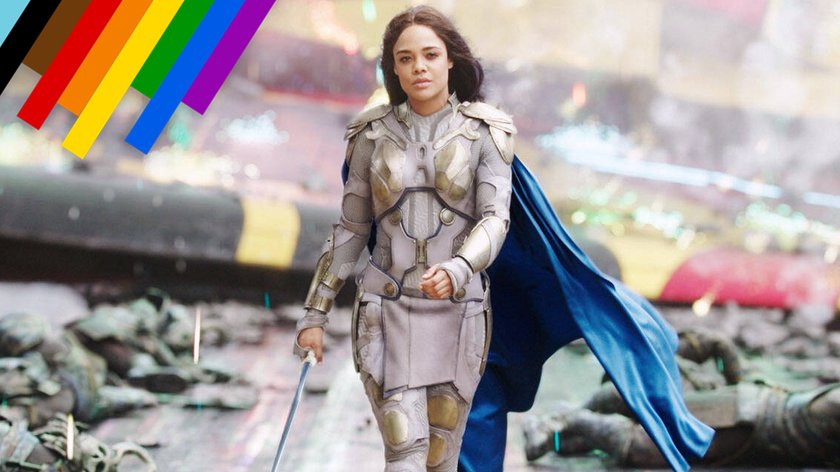
Something is happening in terms of representation in the big Marvel Cinematic Universe. But why did it take so long? And why does it usually only seem like lip service?
“With great power comes great responsibility.” Countless people across the globe are familiar with this quote from Spider-Man’s Uncle Ben, which is inseparable from the identity of the world’s most beloved superhero. After all, it is a must-have in almost every story about the friendly neighborhood spider. Thanks to “Spider-Man: No Way Home,” the quote made it into the Marvel Cinematic Universe (MCU) for the first time, which unfortunately does not always adhere to this slogan.
The MCU is the highest-grossing film franchise of all time, and it looks set to expand that lead in the years to come. Even as the much-predicted superhero fatigue is starting to kick in – see “Ant-Man and the Wasp: Quantumania” – the films continue to rake in hundreds of millions of dollars at the box office worldwide. In addition, several MCU series are launched each year, which are always very popular with the Disney+ streaming service or, in view of major controversies such as “She-Hulk,” at least suggest that many people watch them.
Consequently, the MCU has enormous power and, according to Uncle Ben, great responsibility. Like many blockbusters before them, popular films shape the public’s image of society. Accordingly, the responsibility lies in depicting the true realities of life and, above all, in showing younger cinema-goers that they themselves are a part of society and should show acceptance towards others. Of course, this also includes the LGBTQIA+ community, which, like many other groups, is alarmingly underrepresented in the MCU. The franchise, with its 32 films and eight series and the corresponding number of characters, actually has enough chances to ensure more representation. But why didn’t this happen for a long time? Where is the MCU today? And is there any improvement in sight?
The fish rots from the head.
The name Isaac “Ike” Perlmutter is probably only known to people who have really studied the Hollywood entertainment industry. Perlmutter, who was born in 1942, determined the fortunes of Marvel Entertainment as CEO for years and thus also of Marvel Studios until 2015. That year, Marvel Studios President Kevin Feige, who is considered the architect of the MCU, was able to free himself from Perlmutter’s stranglehold. You really have to give him credit for that, because according to Hulk actor Mark Ruffalo, Feige threatened his departure from Marvel in the wake of the first Avengers film in 2012 because Ike Perlmutter blocked more diversity in the MCU (via CBR).
Perlmutter, who donated millions to Republican politicians, including Donald Trump, has long been notorious in Hollywood for his backward-looking views. For example, he is said to have played down the casting change of James “Rhodey” Rhoades from Terrence Howard to Don Cheadle in the MCU with the racist comment that all black people “look the same” and audiences won’t really notice the change (via Financial Times).
In 2019, when Feige rose to CCO of Marvel Entertainment and has since overseen the creative direction of the entire MCU, he confirmed to The Hollywood Reporter (via IGN) that Perlmutter’s veto of Feige’s desired representation was the reason behind the 2015 realignment. Even if the portrayal that the lack of diversity in the MCU was due to a single man is certainly too simplistic, since Perlmutter’s influence fell and Feige’s rose, a clear change in the franchise is actually noticeable. “Black Panther” was the first solo film by a non-white superhero in the MCU in 2018, and the following year, eleven years after the start of the MCU, “Captain Marvel” finally had a woman leading the first title in the series as the protagonist. Over the course of Phase 4, launched in 2021, this trend became even more evident thanks to projects like “Shang-Chi and the Legend of the Ten Rings,” “Eternals,” and “Ms. Marvel.” However, progress for the LGBTQIA+ community has been much slower.
The status quo: cut out, hidden, or not important enough.
In 2017, the time had actually come: The first queer MCU character was supposed to make a grand entrance. And not just anyone, but Valkyrie, the tough warrior from Asgard, played by Hollywood star Tessa Thompson and one of the most important newcomers in “Thor: Ragnarok,” was expected to ensure this premiere. A corresponding scene was even shot, which briefly shows a woman leaving Valkyrie’s room. However, we never got to see it, allegedly because the shot distracted from the narrative element of the moment (via Rolling Stone). So we only found out afterward – unfortunately, as is often the case in Hollywood works – that Valkyrie is bisexual in the MCU.
The LGBTQIA+ debut, therefore, belonged to the grieving man in “Avengers: Endgame,” who, during a therapy session with Captain America (Chris Evans), spoke about dating a man. The fact that this grieving man, played in a single scene by Endgame director Joe Russo, wasn’t even given a name should be telling enough for this premiere.
However, Phase 4 of the MCU was also on the right track in this area, although there is still room for improvement. Loki (Tom Hiddleston) came out as bisexual in his series of the same name, but we never got to see him in a relationship or even in a relationship with a man. The fact that Loki is also gender-fluid was revealed in his file with the Time Variance Authority (TVA). However, to discover that, you had to take a very close look, which most of us probably learned about afterward through reporting on the internet and comments on social media, but not in the series itself.
The portrayal of Phastos (Brian Tyree Henry) in “Eternals” seemed like a really important step in the right direction. The openly homosexual superhero was shown in the film with his husband and their son, finally representing the reality of life for many people in the MCU. Additionally, a different approach was taken in dealing with countries where non-heterosexual relationships are still punishable or socially ostracized. As is often the case, some states asked Disney to cut the scenes featuring the Phastos family from “Eternals.” However, the studio refused to do so this time, prioritizing representation over revenue from those countries.
This happened again with “Doctor Strange in the Multiverse of Madness,” where the presence of America Chavez’s (Xochitl Gomez) mothers led to the Marvel film being banned in some countries. Once again, Disney remained stubborn and did not comply with the demand to cut out the scene with America’s mothers. By the way, America Chavez is a lesbian in the comics, which was not addressed in “Doctor Strange in the Multiverse of Madness.” Only a rainbow pin could be seen on her jacket. Sometimes it still seems like the MCU takes two steps in the right direction and then one step back.
Happy too soon?
The fact that Disney no longer seems intent on preventing its own films from being banned in some countries gave reason for hope. After all, that’s why representation was often kept small, making it easier to remove appropriate scenes for certain markets. Unfortunately, it has to be said that remarkably little has happened in the MCU since “Doctor Strange in the Multiverse of Madness” was released in cinemas.
“Thor: Love and Thunder” shattered hope in that regard as well. Valkyrie actress Tessa Thompson announced at Comic Con 2019 that her character was looking for her queen (via Cinemablend). However, in the film itself, there was nothing to see. At least the stone giant Korg got a husband with whom he fathered a child, but that was only discussed in a short scene at the end. There were also queer characters in “Ms. Marvel,” “She-Hulk,” and “Black Panther: Wakanda Forever,” but they were all supporting characters whose sexual orientation was sometimes only addressed in a single scene.
Maybe Deadpool (Ryan Reynolds) could help with this. It finally raises the question of whether the mercenary with the loose mouth will be portrayed as pansexual, as he is in the comics. This highlights another problem with the franchise: for so long, the titles have ignored the LGBTQIA+ community that the supposed big step of featuring bisexual and gay characters falls short. There are other forms of sexuality and gender identity that are lived by millions of people around the world, and plans for trans*, asexual, and openly non-binary characters are currently unknown.
While progress is certainly evident, the MCU still falls short of being a role model. It should be clear, given the numerous missed opportunities, that the LGBTQIA+ community is tired of the Hollywood mainstream, including the most successful film series of all time, taking so long to catch up with the present.
The MCU is overflowing with characters, but how many names can you remember?




